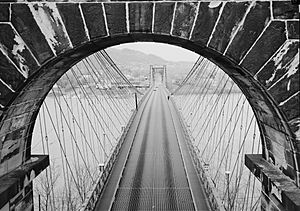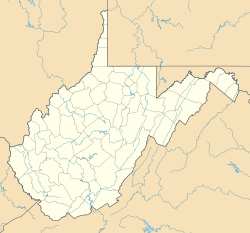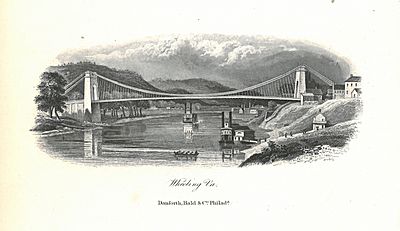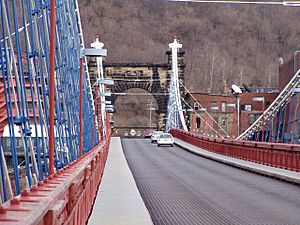Wheeling Suspension Bridge facts for kids
Quick facts for kids Wheeling Suspension Bridge |
|
|---|---|

View from the Wheeling Suspension Bridge, 1977. Photo taken from City of Wheeling side, looking west toward Wheeling Island.
|
|
| Carries | Pedestrians |
| Crosses | Main channel of the Ohio River |
| Locale | Wheeling, West Virginia |
| Characteristics | |
| Design | Suspension bridge Originally: gravity-anchored Currently: cable-stayed |
| Longest span | 308 meters (1,010 ft) |
| History | |
| Designer | Original: Charles Ellet Jr. Redesigner: Wilhelm Hildenbrand |
| Construction begin | 1847 |
| Construction end | 1849, 1854, 1859, 1872 |
|
Wheeling Suspension Bridge
|
|
|
U.S. Historic district
Contributing property |
|

Photo taken from Wheeling Island side, looking east toward the City of Wheeling
|
|
| Location | Wheeling, West Virginia |
| Architect | Charles Ellet Jr., Washington Roebling |
| Part of | Wheeling Island Historic District (ID92000320) |
| NRHP reference No. | 70000662 |
| Significant dates | |
| Added to NRHP | January 26, 1970 |
| Designated NHL | May 15, 1975 |
| Designated CP | April 2, 1992 |
The Wheeling Suspension Bridge is a famous suspension bridge that crosses the main part of the Ohio River in Wheeling, West Virginia. When it was finished in 1849, it was the longest suspension bridge in the world for two years.
Charles Ellet Jr. designed this important bridge. It was the first bridge to cross a major river west of the Appalachian Mountains. The bridge connected the eastern and western parts of the National Road. This made it very important during the American Civil War.
Over time, the bridge faced challenges. Steamboats with tall smokestacks found it hard to pass under. This led to legal battles in the United States Supreme Court. The bridge was originally built for horse-drawn carriages. Because of this, it now has a low weight limit of 2 tons. It was closed to cars in September 2019. Today, only pedestrians and bicycles can use it.
The main part of the bridge is 1,010 feet (310 m) long between its two towers. The east tower is on the Wheeling side, and the west tower is on Wheeling Island. The east tower stands 153.5 feet (46.8 m) above the river's low water level. The west tower is 132.75 feet (40.46 m) above low water.
The Wheeling Suspension Bridge was named a National Historic Landmark on May 15, 1975. It is also part of the Wheeling Island Historic District.
Contents
Building the Wheeling Bridge
A company called the Wheeling and Belmont Bridge Company was given permission in 1816 to build a bridge. This bridge would help the National Road cross the Ohio River. The National Road was a major route that started in Cumberland, Maryland. It reached Wheeling on August 1, 1818. However, people and goods still had to use ferries to cross the river.
For many years, building a bridge across the Ohio River was difficult. There were many arguments about it.
Challenges and New Ideas
The Ohio River was a very important waterway for trade. Goods could travel cheaply from cities like Pittsburgh and Wheeling down to the Mississippi River. From there, they could reach New Orleans, Louisiana.
However, crossing the Ohio River at Wheeling was slow and costly. Ferries carried mail, people, and goods. In 1835, Congress gave parts of the National Road to the states. This was to help with maintenance costs.
New technologies like steamboats and railroads were changing travel. Pittsburgh and Wheeling both wanted to be major trade centers. They competed to connect the east and west. Other states like Pennsylvania and New York were also building canals and railroads.
Virginia, where Wheeling was located, also wanted to improve its transportation. But its leaders wanted trade to go to its own cities like Richmond and Norfolk. They didn't want it to go to Baltimore or Pittsburgh.
For a long time, Pennsylvania lawmakers stopped federal plans for the Wheeling bridge. They worried it would hurt their own trade routes. In 1836, engineers suggested a suspension bridge with a part that could be removed for steamboats. But Congress didn't approve it.
Finally, in 1847, new companies were formed to build the bridge. The Baltimore and Ohio Railroad also reached Wheeling in 1853. This made the bridge even more important.
Bridge Construction
In 1847, the states of Virginia and Ohio gave permission for a new Wheeling bridge. Two famous engineers, Charles Ellet and John A. Roebling, were asked to submit designs.
Ellet's design was chosen. He bid $120,000 for the project. Construction started in 1847. The bridge was finished in 1849, costing about $250,000. It was designed to be 90 feet (27 meters) above low water. However, steamboat smokestacks kept getting taller. This meant the bridge would block the largest boats.
Legal Battles in Court (1849–1852)
The new bridge caused a big legal fight. This was because it was the first bridge to cross a major river west of the Appalachian Mountains. The laws about bridges and rivers were not clear yet.
Pennsylvania and Pittsburgh businesses sued to stop the bridge. They said it blocked the Ohio River, which was a public waterway. They argued that their new steamboats with tall smokestacks would be damaged. They also said it would hurt their own trade routes.
The Wheeling Bridge Company argued that the bridge helped mail delivery and connected military posts. They also said that steamboat smokestacks could be lowered.
The Supreme Court heard the case. In 1850, the Court appointed an expert to study the issue. In 1852, the Court decided that the bridge did block the river. It ordered the bridge to be raised to 111 feet (33.8 meters) or have a removable section. However, the bridge was allowed to stay standing.
Bridge Damage and Rebuilding (1854–1856)
On May 17, 1854, a strong windstorm badly damaged the bridge's deck. It twisted and moved up and down. This led to another legal battle.
A judge tried to stop the bridge from being rebuilt. But the rebuilding continued anyway. Workers made temporary repairs in just eight weeks. More improvements were made later.
The bridge company asked Congress for help. They argued that the judge's order went against the power of Congress and Virginia. The states of Ohio, Virginia, and Indiana also asked Congress to save the bridge.
Congress passed a law that called the bridge a "post road." This meant it was important for mail delivery. This law was key to the Supreme Court's decision in 1856. The Court then upheld the bridge. It said Congress had the power to approve bridges important for military and postal routes.
Bridge Improvements and Impact
In 1859, William McComas made more improvements to the bridge. The completion of the B&O Railroad to Wheeling in 1853 changed transportation. It made steamboat travel less popular. More bridges were planned for other parts of the Ohio River.
A bridge was also built across the Mississippi River in 1856. This bridge also faced legal challenges. A famous lawyer, Abraham Lincoln, defended it in a lower court.
The Bridge During the Civil War
During the American Civil War, Union forces controlled Wheeling. The Wheeling Suspension Bridge was very important for the Union. It was never destroyed by Confederate forces, even though they often attacked the Baltimore and Ohio Railroad.
The bridge's designer, Charles Ellet, and his son helped the U.S. Navy. They used their engineering skills to design special ships. Colonel Ellet led a fleet of ships on the Mississippi River. He died from injuries during the First Battle of Memphis in 1862. This battle was an important Union victory.
West Virginia became a new state in 1863. This happened after a meeting in Wheeling.
Later Upgrades
In 1874, William Hildenbrand oversaw more improvements to the Wheeling Bridge. In 1953, a report found that some of the suspension cables were original or from the 1860s. Extra support cables were added in 1871–72.
The bridge was sold to the city of Wheeling in 1927. More repairs were done in 1930.
In 1956, the bridge deck was completely rebuilt. The road was made wider, and the sidewalks became narrower. The new deck used an open steel grating. This helps reduce wind resistance.
Modern Use and Rules
The bridge spans 1,010 feet (310 m) across the Ohio River. It is still the oldest vehicle suspension bridge in the United States that is still used. It is a National Historic Landmark and a Historic Civil Engineering Landmark.
In the early 1980s, the West Virginia Division of Highways fixed up the bridge. The bridge is still used, but it has strict weight and height limits. This is because it was built before cars and trucks existed. Back then, a horse and buggy was the heaviest thing expected to cross.
Today, the bridge has a weight limit of 4,000 lb (1,800 kg) per vehicle. This means trucks, buses, and other heavy vehicles cannot use it.
- On February 17, 2011, a car crashed into the bridge's sidewalk panels. The bridge was closed for several days for repairs.
- On March 2, 2013, a cable snapped. The bridge was closed until it was fixed and inspected.
- On March 23, 2016, the bridge was closed to all traffic after a Greyhound bus tried to cross and damaged it. It reopened later with its limits still in place.
- In May 2016, police started enforcing the weight and vehicle separation limits more strictly. Cars are advised to stay at least 50 feet (15 m) apart. Traffic lights also control how many cars can enter the bridge at once.
On September 24, 2019, the West Virginia Department of Transportation closed the bridge to cars for good. This was because drivers kept ignoring the weight limits. Earlier that year, a tour bus got stuck under a barrier. Even after officials added a height barrier, drivers continued to ignore the rules.
The bridge remains open for pedestrians and bicyclists. Officials are working on a long-term plan to keep the bridge safe for the future. The bridge will be maintained and preserved, even if cars are not allowed back on it.
See also
 In Spanish: Puente Colgante de Wheeling para niños
In Spanish: Puente Colgante de Wheeling para niños





